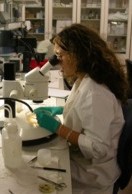|  |
 |
 |
 |
 |
 |
 |
 |
- PATHMEDA was coordinated by the University of Valencia. It involved a knowledge-acquisition phase consisting in secondments in partner teams at the University of Copenhagen and University of Bergen and a second phase where the new knowledge gained was adapted and optimized to Mediterranean fish species at the University of Valencia. The second phase involved the recruitment of three Marie Curie Fellows.
| Morphological and molecular characterization of a new Kudoa
species (Myxozoa) from grey mullets based on 18S rDNA sequences. Solid
evidence for important amendments to the morphological diagnosis of the
genus Kudoa were presented, which will facilitate further diagnosis of
these important fish parasites. | |
|
Development and optimization of a multiplex PCR assay for detection of Vibrio vulnificus biotype2. This procedure afforded a more simple identification of the bacterium in fish, even in subclinical carrier fish. | |
|
Elucidating the role of the metalloprotease Vvp and the virulence plasmid pR99 of V. vulnificus serovar E in surface colonization and innate immunity of eels. These studies have determined the different roles of these two elements in infecting eels and represent a huge leap forward in understanding the infection process of ells by V. vulnificus. | |
|
Understanding the diversity of the virulence plasmid of V. vulnificus. Plasmids are DNA molecules that are separate from the chromosomal DNA, which provide a mechanism for horizontal gene transfer within a population of microbes. The plasmid content of a wide collection of strains from the three biotypes of V. vulnificus was analyzed to identify putative conjugative and virulence plasmids. Results showed that plasmids are widespread among V. vulnificus strains, which seem to substantially contribute to genetic plasticity of the species. | |
|
Establishing mechanisms of genetic regulation of virulence and resistance to antibiotics in V. vulnificus biotype 2 serovar E. Our findings provided a deeper insight into the virulence factors of this microbe. | |
|
Evaluation of genotypic and phenotypic methods to distinguish clinical and environmental strains of V. vulnificus. PATHMEDA evaluated different typing methods to distinguish clinical and environmental isolates. None of the phenotypic methods was reliable enough to determine the origin of the strain of a given isolate. The genotypic techniques classified the samples into three main profiles but no single genotypic method allows at the present time distinguishing environmental from clinical strains or biogroups of V. vulnificus. | |
|
New information of the mechanisms of quorum sensing in V. vulnificus biotype 2 serovariant E. Quorum sensing is a control mechanism of gene expression that accounts for coordinated social behaviour of individual bacteria in response to extracellular signals. The studies carried out under PATHMEDA demonstrated that the gene luxS, which codifies AI-2, is present in all strains of V. vulnificus independently of its origin, biotype or serovariant. Moreover, it was also shown that V. vulnificus also produces quorum-sensing signals elicited by acylated homoserine lactones (AHLs) in strains of biotypes 1 and 2 from the water or wounds in fish and humans. | |
| New insights into the phylogeny and epidemiology
of V. vulnificus. The phylogeny and
epidemiology of V. vulnificus was
studied by Multilocus Sequence Analysis by means of the partial sequencing of
four cellular genes of maintenance and three of virulence of 100 environmental
and clinical stocks of different biotypes, geographic serotypes and origins.
Results showed that the species does not have a clonal population structure and
the species is divided in two main groups and not in three as previously
thought. This finding is extremely important to understand the epidemiology of V. vulnificus in the interface between
wild and cultured fish stocks. | |
| Isolation, detection and sequencing of the Infectious Pancreatic Necrosis Virus (IPNV) from eels. The IPNV present in wild glass-eels was isolated and sequenced. A real-time PCR assay was developed to detect the pathogen in glass-eels arriving to a local eel farm in Spain. The results demonstrate that the glass-eels are already infected upon arrival to the plant. |
|
Roig FJ, Sanjuan E, Llorens A, Amaro C. A (2010) pilF polymorphism-based PCR to
differentiate Vibrio vulnificus
strains potentially dangerous to public health. Applied and Environmental Microbiology 76:
1328-1333. | |
| Hodneland K, García R, Balbuena JA, Zarza C and Fouz B (2011) Real-time RT-PCR detection of betanodavirus in naturally and experimentally infected fish from Spain. Journal of Fish Diseases 34: 189-202. | |
| Fouz B, Llorens A, Valiente
E & Amaro C. | |
| Valiente E, Bruhn JB, Nielsen KF, Larsen JL, Roig FJ, Gram L, Amaro C. 2009. Vibrio vulnificus produces quorum sensing signals of the AHL-class. FEMS Microbiology Ecology 69: 16-26. | |
| Sanjuan E, Oliver JD, Amaro C. 2009. Evaluation of genotypic and phenotypic methods to distinguish clinical from environmental Vibrio vulnificus strains. Applied and Environmental Microbiology 75: 1604-1613. | |
Roig FJ, Llorens A, Fouz B, Amaro C. 2009. Spontaneous
quinolone resistance in the zoonotic serovar of Vibrio vulnificus. Applied
and Environmental Microbiology 75: 2577-2580. | |
| Roig FJ and Amaro C. 2009. Plasmid diversity in Vibrio vulnificus biotypes. Microbiology 155: 489-497. | |
|
Valiente E, Padrós F, Lamas J, Llorens A and Amaro C
(2008) Microbial and histopathological study of the vibriosis caused by Vibrio vulnificus serovar E in eels: The
metalloprotease Vvp is not an essential lesional factor. Microbial Pathogenesis 45: 386-393. | |
| Valiente E, Jimenez N, Merino S, Tomas JM, Amaro C (2008) Vibrio vulnificus biotype 2 serovar E gne but not galE is essential for lipopolysaccharide biosynthesis and virulence. Infection and Immunity 76: 1628-1638. | |
| Valiente E, Lee CT, Lamas J, Hor L and Amaro C (2008) Role of the virulence plasmid pR99 and the metalloprotease Vvp in resistance of Vibrio vulnificus serovar E to eel innate immunity. Fish and Shellfish Immunology 24: 134-141. | |
| Valiente E, Lee CT, Hor L, Fouz B and Amaro C (2007) Role of the metalloprotease Vvp and the virulence plasmid pR99 of Vibrio vulnificus serovar E in surface colonization and fish virulence. Environmental Microbiology 10: 328-338. | |
| Holzer AS, Blasco-Costa I, Sarabeev VL, Ovcharenko MO and Balbuena JA (2006) Kudoa trifolia sp. n. - molecular phylogeny suggests a new spore morphology and unusual tissue location for a well known genus. Journal of Fish Diseases 29: 743-755. | |
| Sanjuán E and Amaro C (2007) Multiplex PCR assay for detection of Vibrio vulnificus biotype 2 and simultaneous discrimination of serovar E strains. Applied and Environmental Microbiology 73: 2029-2032. |

